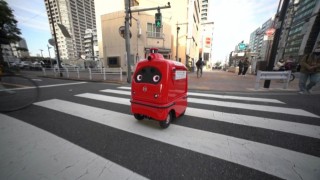Loading
Search
▼ Japan Will Allow Self-Driving Delivery Robots To Roam Its Streets To Combat Labour Shortages
- Category:Other
Amid labour shortages and problems of rural isolation, Japan is relaxing its traffic laws to allow autonomous delivery robots to take to the streets.
Japan has one of the world's oldest populations, with nearly 30 per cent of its citizens aged over 65. Many live in depopulated rural areas that lack easy access to daily necessities.
Labour shortages in its cities and new rules limiting overtime for truck drivers also make it difficult for businesses to keep up with delivery demands.
Being touted as a possible solution are self-driving robots.
"The shortage of workers in transport will be a challenge in the future," said Dai Fujikawa, an engineer at electronics giant Panasonic, which is trialling delivery robots in Tokyo and nearby Fujisawa.
"I hope our robots will be used to take over where needed and help ease the labour crunch," he told AFP.
Japanese robotics company ZMP has partnered with behemoths such as Japan Post Holdings in its own trials of delivery robots in Tokyo.
Its ‘DeliRo’ robot has successfully dodged pedestrians and peddled snacks on a street outside Tokyo. When blocked by passers-by, it’s programmed to show a teary eye.
People in Japan have so far reacted positively to the move.
"I think it's a great idea," Naoko Kamimura said after buying cough drops from Panasonic’s Hakobo.
"Human store clerks might feel more reassuring but with robots, you can shop more casually. Even when there's nothing you feel is worth buying, you can just leave without feeling guilty," she said.
'Spread of robots will be gradual'
However, authorities don't believe Japanese streets will soon be teeming with robots, given the pressure to protect human employment.
"We don't expect drastic change right away, because there are jobs at stake," Hiroki Kanda, an official from the trade ministry promoting the technology.
Experts concede that the "spread of robots will be more of a gradual process".
Regulations mean that a maximum speed for the robots is set at 6 km/h to mitigate the "chances of severe injury in the event of a collision," according to Yutaka Uchimura, a robotic engineering professor at Shibaura Institute of Technology (SIT).
Panasonic says its "Hakobo" robot can detect obstacles and judge autonomously when to turn and stop.
It’s also simultaneously monitored by the Fujisawa control centre, which will automatically be alerted via cameras whenever the robots are stuck or stopped by obstacles.
- February 13, 2023
- Comment (0)
- Trackback(0)


